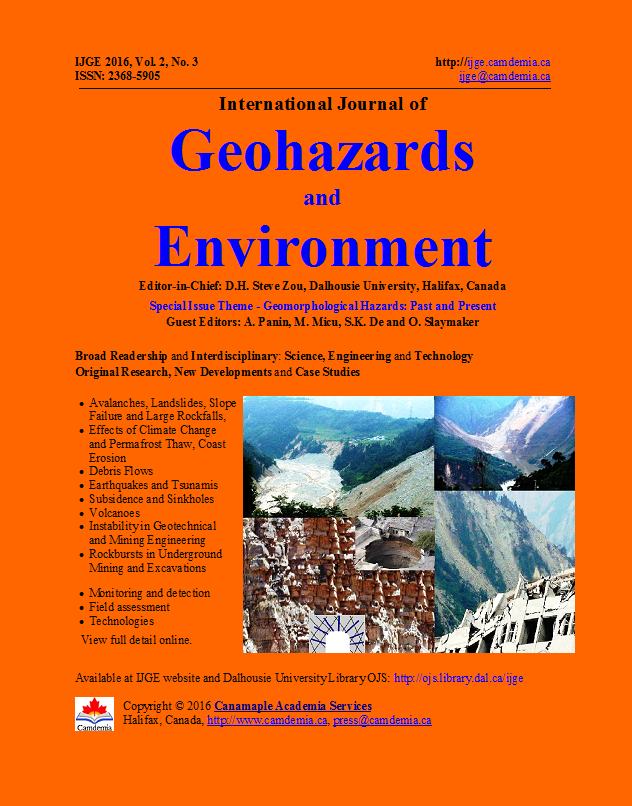Modern and Late Holocene Flash Floods in the Silesian Upland (Southern Poland) Detected from Transformation of Periglacial Valleys: Case Study near Kromołów
DOI:
https://doi.org/10.15273/ijge.2016.03.017Keywords:
periglacial valley, flash floods, relief, sediments, SubatlanticAbstract
The examined area is located in southern Poland in the Silesian Upland. This northern Upper Silesia region is in the headwaters of the Warta river, a tributary of the Oder river. Some dry, fluvio-denudational valleys (dells) form a drainage pattern around Kromołów, which is a part of Zawiercie City. These dells, which were formed in periglacial conditions of the Pleistocene, are relict forms very typical of the Polish Uplands. These Pleistocene valleys were rejuvenated during the Holocene. A good example of this type of relief transformation is a small dry valley located near center of Kromołów. The first-phase of headward erosion reached upper section of this valley in the Subatlantic as documented by radiocarbon dating of a buried soil (2,570±80 BP, cal. 847 - 428 BC) preserved on the old valley bottom (terrace). Archaeological data from Archaeological Map of Poland (AZP) do not confirm prehistoric settlement in the study area. Incision of the valley floor could not be attributed to anthropogenic deforestation as the first settlements occurred within the last few hundred years. However, the absence of older archaeological sites might be caused by intensive soil erosion which could have destroyed them. Large scale soil erosion is confirmed by thick (about 3 m) series of deposits with fragments of 17 - 18 c. pottery accumulated in the middle section of the valley. Some members with fining upward sequence could be distinguished in this series. Then the older valley floor of trough was first covered with sediments of flash floods and subsequently cut by an ephemeral stream. Erosion to a depth of 3 - 4 meters and a length of almost 800 meters occurred in the middle section. This accumulation and incision was associated with flash floods which were the main morphogenetic factor of transformation of this valley type during the Holocene.Downloads
Published
Issue
Section
License
Copyright, Terms and Conditions
The International Journal of Geohazards and Environment (the Journal) is published by Canamaple Academia Services (the Publisher) online with open access, under a Creative Commons Attribution-Noncommercial license (CC-BY-NC) (http://creativecommons.org/licenses/by-nc/4.0/). Authors (the Authors) submitting papers (the Work) for publication in the Journal automatically agree to the following terms and conditions.
1. Under the license (CC-BY-NC), Authors give permission for others to share and reuse the Work, as long as the original source and author(s) are properly cited (i.e. a complete bibliographic citation and link to the Journal website) and the material is not used for commercial purposes. Any sharing or reuse must however indicate the original CC-BY-NC license terms of the work.
2. Authors transfer and assign to the Publisher all copyright in and to the Work. However Authors retain all proprietary rights except the copyright, related to the Work and also retain the rights a) to use, reproduce, distribute, and publicly display the Work in any medium in connection with the Authors‘ academic and professional activities, such as teaching, presentations and lectures, b) to create derivative works from the Work and to make full use of the Work in future research and publications, c) to authorize others to make any non-commercial use of the Work, d) to make both the pre-published and final-published versions available online in institutional and/or disciplinary repositories or on their own websites with a citation and link to the original paper published in the Journal.
3. Authors warrant that the Work is their original work, it is not copied from anywhere or anyone else, they are totally responsible for the authenticity, originality, validity and accuracy, and the facts and views are their own, that the Work contains no matter which is defamatory or infringes any literary or proprietary rights, intellectual property rights, or any rights of privacy, and that the Work has not been simultaneously submitted to any other journals or publishers. Authors further agree that their manuscripts whether accepted or rejected will not be returned and the rejected manuscripts will be disposed at the journal editor's discretion.
Disclaimer: The Publisher, the Journal and the editors accept no responsibility for statements or opinions expressed by authors. Use of information and materials in the Journal is the sole responsibility of users.


